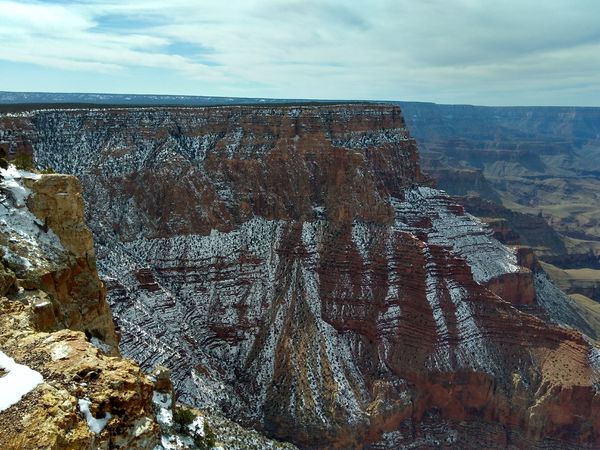Headline ! Camera sales plummet !
Feb 17, 2019 02:45:12 #
User ID wrote:
Mebbe he's going stricklee by the rules.
The apostrophe would then be required
for the missing letters in "photographs".
So it's not a plural. It's a contraction :-)
The apostrophe would then be required
for the missing letters in "photographs".
So it's not a plural. It's a contraction :-)
Contractions - Grammar
"A contraction is a shortened version of the written and spoken forms of a word, syllable, or word group, created by omission of internal letters and sounds"
https://en.wikipedia.org/wiki/Contraction_(grammar)
The missing letters or words are replaced by an apostrophe.
We are used to seeing contractions used to shorten two words, for example: doesn't for does not; won't for will not; that's for that is.
However there are contractions for single words:
ma'am for madam, can't for cannot
Since photograph is a compound word the argument is that photo's is the contracted form.
However photos has evolved into a word by itself, it is the short form of photograph. Photos is the plural.
Ref: https://dictionary.cambridge.org/us/dictionary/english/photo
and https://www.dictionary.com/browse/photo
Given the above, photo's, with apostrophe, would denote possession. Thus is it correct to use photos, no apostrophe, to denote multiple photographs.
Feb 17, 2019 03:48:29 #
User ID wrote:
Well, if you cannot parse that, you
got no cred as a Grammar Cop. So
please surrender your shield.
.
Well, if you cannot parse that, you
got no cred as a Grammar Cop. So
please surrender your shield.
.
I hope you’re not helping your kids with grammar homework. 😜🤪
Feb 17, 2019 06:40:24 #
I want too know why all these grammar police on the This forum. And did someone appoint them as the grammar god. Who the heck gives a darn any way?
I say if it ruffles your feathers because someone miss spelled a word or forgot a apostrophe so what let it go.
I say if it ruffles your feathers because someone miss spelled a word or forgot a apostrophe so what let it go.
Feb 17, 2019 13:23:08 #
It's true,I have let the site down and most of all i've let myself down.
However there are over 2330 examples of the usage on this site, site:uglyhedgehog.com "photo's" however it may be of some comfort that 37,200 times photos was used correctly .
Jane Straus, May 18, 1954—February 25, 2011,
Author of the original Blue Book of Grammar and Punctuation. Had this to say on the subject of "Photo's".
Jane says:
October 29, 2011, at 7:57 pm
The abbreviation of the plural word photographs is photos.
Example: He takes nice wedding photos.
Since you asked about photograph’s with an apostrophe (the singular possessive form), the abbreviation of that word is photo’s.
Example: That photo’s corner is bent.
Rather interestingly the quote is from 9 months after her death, so presumably is quoted from her book.
It's arguable that when I referred to the content of photo's I was using the the singular possessive form of photograph as a collective noun.
I wrote "There is a big difference in the content of the photo's" is being the singular verb form which agrees with the collective noun photo and content is a possession of photograph.
Is the following correct? "the government's policy". There are different rules in American and British punctuation where to put the full stop, period.
https://www.grammarbook.com/jane_straus.asp Thank you jane
https://www.amazon.com/Blue-Book-Grammar-Punctuation-Easy/dp/1118785568 for the grammar nazi in your life.
However there are over 2330 examples of the usage on this site, site:uglyhedgehog.com "photo's" however it may be of some comfort that 37,200 times photos was used correctly .
Jane Straus, May 18, 1954—February 25, 2011,
Author of the original Blue Book of Grammar and Punctuation. Had this to say on the subject of "Photo's".
Jane says:
October 29, 2011, at 7:57 pm
The abbreviation of the plural word photographs is photos.
Example: He takes nice wedding photos.
Since you asked about photograph’s with an apostrophe (the singular possessive form), the abbreviation of that word is photo’s.
Example: That photo’s corner is bent.
Rather interestingly the quote is from 9 months after her death, so presumably is quoted from her book.
It's arguable that when I referred to the content of photo's I was using the the singular possessive form of photograph as a collective noun.
I wrote "There is a big difference in the content of the photo's" is being the singular verb form which agrees with the collective noun photo and content is a possession of photograph.
Is the following correct? "the government's policy". There are different rules in American and British punctuation where to put the full stop, period.
https://www.grammarbook.com/jane_straus.asp Thank you jane
https://www.amazon.com/Blue-Book-Grammar-Punctuation-Easy/dp/1118785568 for the grammar nazi in your life.
Feb 18, 2019 18:14:43 #
So, to get this thread back on track, these photos, and many others, where taken with my Motorola cell phone, Feb. of last year. Good pics, I think. BUT, I felt I could do so much better, and have more options. I now own several Nikon DSLR's, am learning everything I can about how to use them, correctly, AND teaching my 10 and 12 year old sons how, as well. Do I still use the cell phone for pics? Sure, but not nearly as often as we use our DSLR'S. REAL cameras are here to stay.


Feb 18, 2019 18:27:38 #
Robert1 wrote:
"My 17 year old great niece took a photograph... (show quote)
No creative art can thrive in a vacuum. There has to be:
* demand for its works
* funding (patrons)
* legal protection for creators/performers/artists
* education (a young dancer doesn't get to be a prima ballerna by buying a copy of Ballet for Dummies
* facilities, materials and tools
* a "scene" -- people who know about and appreciate the art form
It's rather like sports: it takes 12 million American kids playing basketball to create 300 NBA players.
And that's assuming there are enough coaches, scouts and college teams to develop these players.
Kids don't have to pay for the coaching they receive in school or in college--or to rent the court.
By the college level, coaching is pretty good. But who trains photographers? Get your Four Thirds
camera and your copy of PhotoShop and you're on your way to being Ansel Adams....uh, not quite.
Wedding photography can exist as business as long as their are brides who want photos of their wedding,
but fine art photography requires galleries, collectors, and museums. Portrait photography requires
sitters willing to pay for portraits.
Dorothea Lange didn't pay out of her own pocket to photograph migrant workers--the FSA paid.
Ansel Adams didn't pay out of his own pocket to phtograph the National Parks--the Park Service paid.
Alfred Stieglitz's phorotraphic work was supported by his gallery, An American Place, in NYC.
Money has dried up, many galleries have closed, sitters have become scarce.
Ask yourself: what is the most I ever paid for a photographic print? Now consider: Andreas Gursky's original
photograph "Rhein II " (1999 -- a chromogenic color print, measuring 73" x 102", mounted on clear acrylic).
It sold at auction at Christie's in NYC in 2011 for $4,338,500 -- the most ever paid for a photograph.
What would it have fetched at your local photo gallery (if there is one)?
Finally, technology is not neutral: some technologies provide a unique, permanent original , others
do not. You're lucky to get more than $400 for an ink-jet print, unless it has already been sold several times
and has unimpeachable provinance.
Manufactuers just want to sell gear. They don't care whether or not its capable of producing valuable prints.
Most buyers don't care either: they think with a Four Thirds camera, a copy of PhotoShop, and one of
Bryan Peterson's books they are all set to be the next Ansel Adams. They don't realize that they would have
a better chance with a camera made from a shoe box.
Automation prevents new photographers from learning the very things that are most important to photograph.
Subminaiture format (almost the same size as 110 cartridge film!) limits quality print size (for straight photography).
If you want to paint a ceiling like Michaelangelo did in the Sistine Chapel, you better not be using a roller
on a pole. Sure that's "higher tech" than a brush, and it's more efficient and conveneint (no lying on your back
on a scaffold for hours and hours). But it just won't look the same.
Each person chooses his priorities as a photographer: is your top priority print quality and value, or camera convenience
and compactness? Do you want "bells & whistles" or image quality? Joe Consumer has made his choice: tiny,
"high-tech", convenient and cheap!
According to Bureau of Labor Statitics estimates, there are only 49,320 people employed as professional
photographers in the US as of 2017 -- out of a population of 326 million. https://www.bls.gov/oes/current/oes274021.htm
Even if every pro in America bought a new camera every year, it would have nelgibible impact on the sales the big
Japanese camera makers. From a marketing standpoint, pros don't matter (except as paid endorsers),
The future of photography is in the hands of consumers--and since 2011 they have been deserting in droves for
smart phone cameras. The market trends say that the future of photogrphy is smart phones -- which means it has no
future except as a consumer passtime: creating images so that they can be deleted within a short time.
No other artist has to compete with consumers for the attention of suppliers. Nike does not make ballet slippers.
Crayola does not make artists' crayons. Sherwin Williams does not make artists oil paints. First Act does not make
violins for concertmasters.
What camera manufactuers do not sell primarily to consumers? Off hand, I can only think of Hasselblad, Sinar
and Phase One/Leaf. Yashica is gone, Zeiss hasn't made a Zeiss Ikon camera since 2004 (and the Zeiss brand for
lenses is licensed to Sony), Voitlander is a zombie brand, and the Mamiya brand is controlled in the USA by a
different company than the camera manufacturer,
Photography only became accepted as fine art around 1900-1930 thanks to the efforts of Alfred Steiglitz
and a three generations of brilliant photographers. Pictorialism began the process of getting photography
taken seriously, but it could not have survived modernism. The "straight photography" got photography
accepted as modern art. But there is no guarantee it will retain that status.
Older works will continue to appreciate and new works by established photographers will command high
prices, but it has gotten very difficult for younger photographers to break into the fine art market, and soon
it may be nearly impossible.
If you want to feel young, check out the ages of the living photographers whose work commands the top prices.
None of them is under the age of 50. Thomas Demand is 55. Andreas Gursky is 64. Sally Mann is (a lovely) 67.
Annie Liebovitz is (a very young) 69. Bruce Barnbaum is 76. Don McCullin is 84.
Photography (the art form) is probably entering a "dark age". But fauxtography (what people do with smart phones
and "selfie sticks") is bigger than ever!
How much are you willing to pay for a stranger's "selfie"?
Feb 18, 2019 18:29:12 #
Funny how some posters are much more worried about spelling and grammar mistakes
then they are by the death of photography as a series pursuit.
Like I said: it comes down to priorities.
then they are by the death of photography as a series pursuit.
Like I said: it comes down to priorities.
Feb 18, 2019 18:36:46 #
blackest wrote:
This is where the cell phone camera designers have been quite clever they use a fixed aperture of typically f1.7 - F2.4 this manages to keep diffraction small enough that it isn't visible when the photo is enlarged, F64 is fine on large format due to the limited magnification that will be applied. It is really nice engineering.
This is where the cell phone camera designers have been quite clever they use a fixed aperture of typically f1.7 - F2.4 this manages to keep diffraction small enough that it isn't visible when the photo is enlarged, F64 is fine on large format due to the limited magnification that will be applied. It is really nice engineering.
This is incorrect.
F-number is defined as focal length divided by diameter.
So the shorter the focal length, the smaller the diameter of a given f-stop.
And the smaller the format, the shorter the focal length for each type of lens (e.g., a "normal" lens).
Smaller format ==> shorter focal length ==> smaller diameter for given f-number ==> more diffraction
f/11 is a much smaller hole on a smart phone camera than on a FF camera, so it has MUCH more diffraction--
more than f/22 on your FF!
There is no "clever" way around this: it is determined by physical laws of light and simple arithmetic.
Feb 18, 2019 20:17:09 #
Bipod wrote:
This is incorrect. br br F-number is defined as f... (show quote)
If a smartphone had a sensor that had an aperture of f11 it would be useless.
however they use quite large fixed apertures such as f1.7, f2.0
iphone has a 1/3" sensor
Pixel Size:
1.2 µm
Maximum Circle of Confusion:
3 µm
Diameter of Airy Disk:
2.7 µm
Diffraction Limited? No
F2.8 would be Diffraction limited but that camera doesn't have an F2.8 aperture to be diffraction limited! It is a single aperture lens.
https://www.cambridgeincolour.com/tutorials/diffraction-photography.htm
http://photoseek.com/wp-content/uploads/Camera-sensor-sizes-2018-PhotoSeek.jpg
Feb 18, 2019 21:10:06 #
Bipod wrote:
No creative art can thrive in a vacuum. There has... (show quote)
You should try to get your facts straight.
The most expensive photograph is made by Peter Lik "Phantom" (2014) - $6,5 million
Feb 19, 2019 12:51:55 #
Bipod wrote:
Funny how some posters are much more worried about spelling and grammar mistakes
then they are by the death of photography as a series pursuit.
Like I said: it comes down to priorities.
then they are by the death of photography as a series pursuit.
Like I said: it comes down to priorities.
Hello Bipod
I think I will just ignore these people from now on I will not acknowledge them for my mis spelling and grammatical errors.
Feb 19, 2019 13:06:08 #
tdekany wrote:
You should try to get your facts straight.
The most expensive photograph is made by Peter Lik "Phantom" (2014) - $6,5 million
The most expensive photograph is made by Peter Lik "Phantom" (2014) - $6,5 million
I believe Gursky's photograph is Fine Art.
The Phantom is Pop Art.
Fine art stands the test of time pop art not so much.
Feb 19, 2019 13:39:03 #
RichardSM wrote:
I believe Gursky's photograph is Fine Art.
The Phantom is Pop Art.
Fine art stands the test of time pop art not so much.
The Phantom is Pop Art.
Fine art stands the test of time pop art not so much.
Quote:
Ask yourself: what is the most I ever paid for a photographic print?
That was his question. My answer is correct.
Feb 19, 2019 18:08:22 #
tdekany wrote:
That was his question. My answer is correct.
Geez you had to prove him wrong wow we!
Feb 19, 2019 18:31:35 #
RichardSM wrote:
I believe Gursky's photograph is Fine Art.
The Phantom is Pop Art.
Fine art stands the test of time pop art not so much.
The Phantom is Pop Art.
Fine art stands the test of time pop art not so much.
So I guess you’re saying guys like Warhol, Indiana and Lichtenstein haven’t stood the test of time. I should tell MOMA and the Hirshorn.
If you want to reply, then register here. Registration is free and your account is created instantly, so you can post right away.





